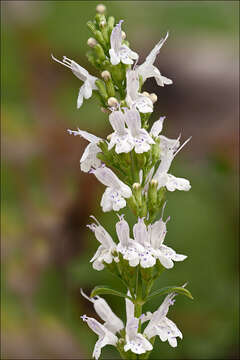Micromeria-thymifolia_4

Description:
Micromeria thymifolia (Scop.) Fritsch, syn.: Saturea thymifolia Scop., Calamintha rupestris HostBalkan Mint, DE: Illyrische BergminzeSlo.: timijanovolistni popovecDat.: Aug. 9. 2016Lat.: 46.36197 Long.: 13.70829Code: Bot_996/2016_DSC4413Habitat: colluvial, almost barren, stony, calcareous ground; side of a mountain ravine, very dry, warm place, full sun, moderately steep mountain slope, south aspect, exposed to direct rain; elevation 600 m (1.970 feet); average precipitations ~ 3.000 mm/year, average temperature 7-9 deg C, alpine phytogeographical region. Substratum: soil among stones.Place: Lower Trenta valley, between villages Soa and Trenta; right bank of the ravine descending from Mt. Srebrnjak, 2.100 m (6.890 feet), reaching the bottom of the valley slightly upstream from Otokar farmhouse, Trenta 4, East Julian Alps, Posoje, Slovenia EC.Comment: This highly aromatic plant is little known in central and northern Europe. It grows mostly in Dinaric, Submediterranean and also Mediterranean montane regions entering the Alps only in their most southeast part in Slovenia and neighboring regions of extreme northeast Italy. In Slovenia one can find it scattered mostly in its southwest part in the submediterranean phytogeographical region near Adriatic Sea. In the Trenta valley it probably reaches its northern most edge of its distribution area. However, in Italy Micromeria thymifolia has been traditionally used as medical and antimicrobial plant and particularly as condiments for a long time. The plant is extremely aromatic. In hot summer days one can smell it from far. There is no need to crash its leaves to be impressed with its strong and pleasant smell. Because of its many uses and recent tendency to broaden the use of condiments and spices in culinary Micromeria thymifolia is recently being developed into a new crop plant (Ref.2.). It appears that its cultural history is approaching a new prosper.Taxonomy of Micromeria thymifolia is an interesting issue. According to many references, including esteemed Ref.1., genus Micromeria in Alpine region knows only a single species, namely Micromeria thymifolia. In its taxonomic history it was attributed first to genus Savory (Saturea) and then to genus Calamint (Calamitha) before becoming Micromeria. However, some authors do not recognize existence of these three genera at all and consider all their species belonging to a single large genus Saturea. Obviously distinguishing traits among them are not too conspicuous and firm, or are at least difficult to discern. Anyway, the plant is beautiful, growing mostly among barrens stones and rocks and in spite of (or because of?) this strikingly aromatic. Ref.:(1) D. Aeschimann, K. Lauber, D.M. Moser, J.P. Theurillat, Flora Alpina, Vol. 2., Haupt (2004), p 144. (2) K. Hammer, G. Laghetti, K. Pistrick, Calamintha nepeta (L.) Savi and Micromeria thymifolia (Scop.) Fritsch cultivated in Italy, Gen.Res. and Crop Evol, Vol. 52. (2004), pp 215-220. available at link.springer.com/article/10.1007/s10722-004-1500-1# (3) A. Martini et all., Mala Flora Slovenije (Flora of Slovenia - Key) (in Slovenian), Tehnina Zaloba Slovenije (2007), p 606. (4) I. Schnfelder, P. Schnfelder, Kosmos Atlas Mittelmeer- und Kanarenflora, Kosmos, (2002), p 180.
Included On The Following Pages:
- Life (creatures)
- Cellular (cellular organisms)
- Eukaryota (eukaryotes)
- Archaeplastida (plants)
- Chloroplastida (green plants)
- Streptophyta
- Embryophytes
- Tracheophyta (ferns)
- Spermatophytes (seed plants)
- Angiosperms (Dicotyledons)
- Eudicots
- Superasterids
- Asterids
- Lamiales ("An Order: Mints, Vervains, Snapdragons, Etc.")
- Lamiaceae (mint family)
- Clinopodium (clinopodium)
- Clinopodium album
This image is not featured in any collections.
Source Information
- license
- cc-by-nc-sa
- copyright
- Amadej Trnkoczy
- photographer
- Amadej Trnkoczy
- original
- original media file
- visit source
- partner site
- Flickr Group
- ID


